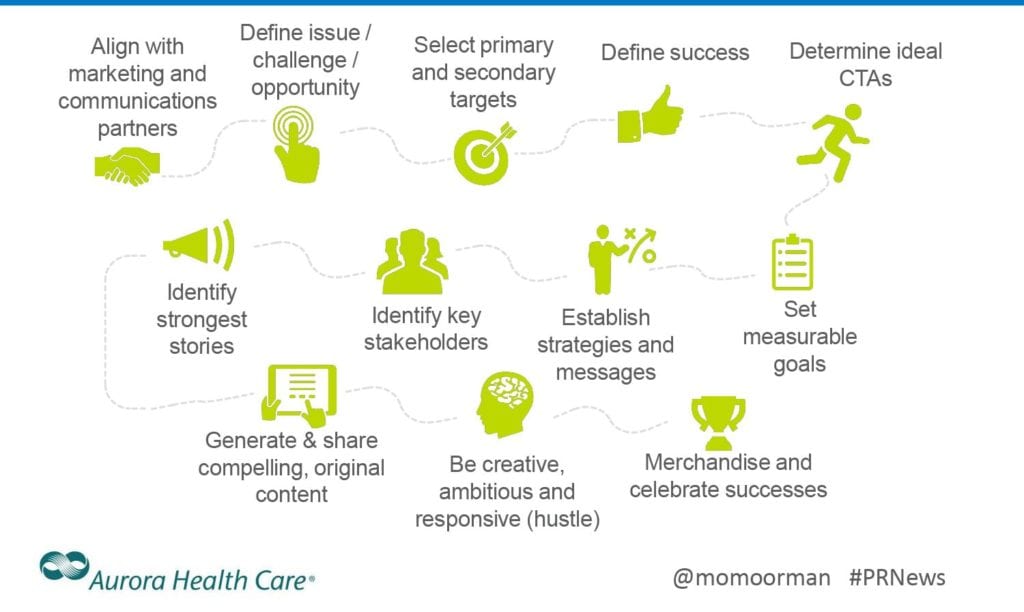
The first month of the year traditionally signals a fresh start. With just a few days remaining in January, there’s still time for brand communicators to take a fresh look at the tactics they employ to generate coverage and awareness of products and services.
We asked an experienced brand communicator for best practices to generate buzz. The tips provided should freshen your efforts this month and for the year to come.
Be A Source, Keep Your Enemies Close

Director of PR & Social Media, Aurora Healthcare
So much buzz is generated via social these days. Still, making sure you continue to practice the basics of PR and communications also can build awareness for brands, says Mo Moorman, director of public relations & social media, Aurora Health Care. Aurora is a nonprofit, integrated health care system, with 32,000 caregivers including 1,800 physicians in 15 hospitals, 150+ clinics and 70 pharmacies.
One practice often overlooked in this all-social-all-the-time era, Moorman says, is being a source of information. To be in a position to supply great information to media requires communicators to initiate, build and maintain close relations with internal stakeholders. Those relationships, he says, can make it easier for you to convince executives to write thought-leadership articles, blog, tweet and appear on industry panels. These activities keep them in front of journalists.
The payoff is that when a journalist writes a story about your competition, it can help your brand. “Articles about our competitors that mention us [because we’ve had physicians provide valuable information to the writer] help build our brand awareness,” he says.
The need for communicators to build relationships with internal stakeholders is critical, he says. It was vital in the above example and can be seen as one of the foundations of Moorman’s 12-part plan for success (see graphic).
12-point plan for communications success

When to Promote
“There’s nothing about my brand that lends itself to social posting or live video.” Moorman could have agreed with that commonplace thinking, but chose to ignore it. Instead he undertook an effort last year to promote St. Luke’s Hospital as two competitors threatened its market-leading status in Milwaukee. Sticking to his 12-part plan, Moorman’s team sought appealing content. It was decided to highlight St. Luke’s variety of procedures and services, and feature Transcatheter Aortic Valve Replacement (TAVR), a heart procedure, to emphasize differentiation from the competition.
Among the tactics Moorman’s team used was a Facebook Live video to publicize TAVR. “For us, showing surgery [live] delivers the message that we do the big stuff…[and believe it or not] surgery is compelling [on video and overtakes what Moorman calls] the gross-out factor” of surgery. Indeed, the vid, first shown in July 2016, had 47,000 views when we checked Jan. 25. That “we are confident enough to show [a procedure live] is a big message [from our brand],” he says.
Indeed, that the once-live video lives indefinitely on Aurora’s Facebook page goes directly to a tip he has for promoting live video. While Moorman will promote a video the day it’s shot and several days and weeks before, “the vast majority of viewers are watching it after” it’s shot, he says. “The more important promotion is after” the video is shot.
Crafted Pitches
To promote TAVR with social, Moorman first identified seniors and the general public as targets for the video. The video was supplemented with a pair of blogs from a leading heart surgeon. In addition, “numerous” posts on Facebook, Twitter and LinkedIn were promoted. Topics were chosen for the “great angle” they offered; they included a celebration of the hospital’s 1,000th TAVR, a 103-year-old woman who got TAVR and is leading an “interesting life” and a Holocaust survivor who got a TAVR. More traditional earned media included a press release touting the above-mentioned 1,000th TAVR at St. Luke’s.
Importantly, Moorman tailored his pitches to particular media outlets. Trade/industry targets were pitched differently than local mass media journalists, who were offered interviews with surgeons, who explained the TAVR procedure. Local business trades were pitched stories on St. Luke’s role as a heart-care destination and surgical training center.
Celebrating TAVR and outcome metrics
There was even a 1,000th TAVR celebration at the hospital, where media, patients, physicians and administrators mingled. Images and video were captured with a smartphone, edited using iMovie and posted that day on Facebook.
In measuring social posts via Google analytics and Cision, Moorman’s KPIs included number of blogs posted and impressions, but concentrated on actions. “Did [our content and other actions] lead to downstream conversion…did consumers make an appointment” with Aurora as a result of our efforts?
CONTACT: [email protected]
